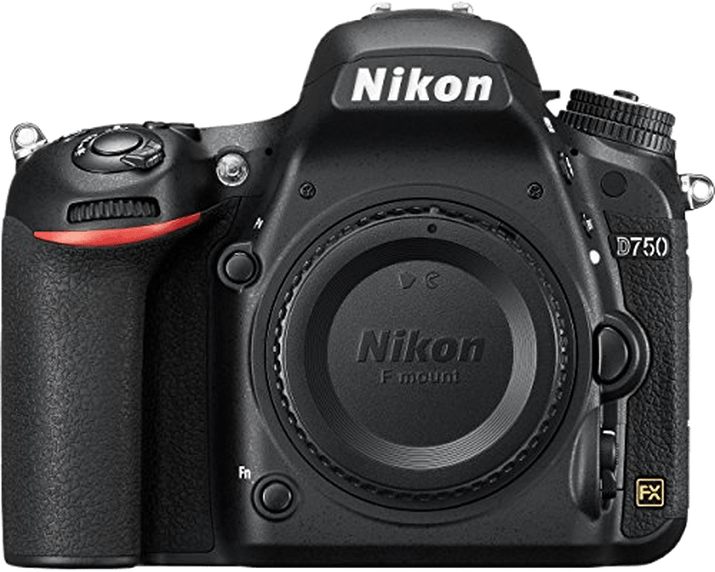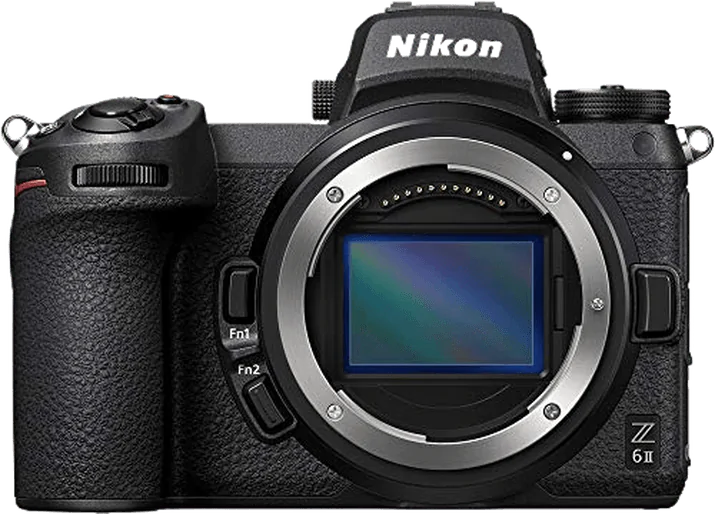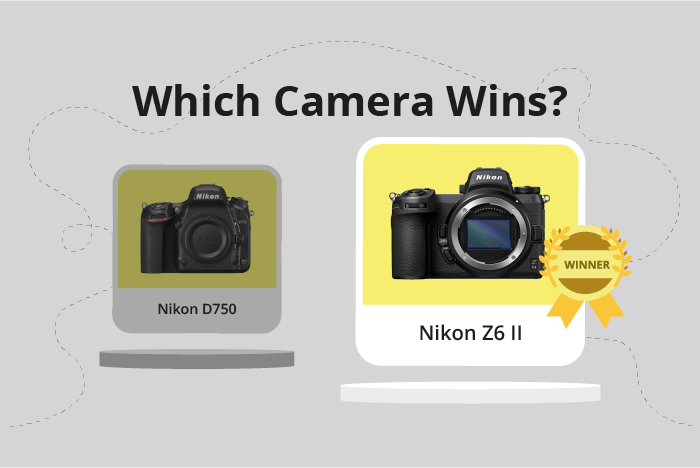Nikon D750 vs Z6 II Comparison
Nikon D750

Nikon Z6 II

The Nikon Z6 II emerges as the winner with a score of 83/100, while the Nikon D750 receives a score of 68/100. Both cameras share similarities, such as being produced by Nikon and having similar launch prices, with the D750 at $2300 and the Z6 II at $1995.
The Z6 II outperforms the D750 with its mirrorless technology, making it a more compact and lightweight option at 134 x 101 x 70mm and 705g. On the other hand, the D750, a DSLR, is slightly bulkier at 141 x 113 x 78mm and 750g. However, the D750 has been on the market since 2014, which may be a benefit for those seeking a more established camera.
Considering the specifications, the Nikon Z6 II is the superior choice due to its advanced features and compact size, while the Nikon D750 may suit those looking for a more traditional DSLR.
Nikon D750 vs Z6 II Overview and Optics
The Nikon Z6 II emerges as the winner in the optics comparison, scoring 83/100, while the Nikon D750 scores 71/100. Both cameras share certain specifications, such as the 24-megapixel range, CMOS sensor type, and full-frame sensor size. However, the Nikon Z6 II outperforms the D750 in various aspects, contributing to its higher score.
The Nikon Z6 II has a higher shooting speed of 14 frames per second (fps), compared to the D750’s 6.5 fps. This allows the Z6 II to capture fast-moving subjects with greater ease. Additionally, the Z6 II has a dual Expeed 6 processor, contributing to its faster performance and better image quality. The camera also has a slightly better DXOMARK sensor score of 94, compared to the D750’s score of 93.
Another advantage of the Nikon Z6 II is its in-body image stabilization, which the D750 lacks. This feature helps reduce camera shake, allowing for sharper images in low-light conditions or when using slower shutter speeds. Furthermore, the Z6 II uses the Nikon Z lens mount, providing access to a new range of high-quality lenses designed specifically for the Z-series cameras.
Despite the advantages of the Nikon Z6 II, the D750 still has some merits. Its Nikon F FX lens mount is compatible with a vast selection of lenses, making it a more versatile option for photographers with an extensive collection of Nikon F-mount lenses.
Taking all these factors into account, the Nikon Z6 II’s superior shooting speed, dual Expeed 6 processor, better DXOMARK sensor score, and image stabilization make it the better choice in terms of optics. However, the D750 remains a viable option for those with a collection of Nikon F-mount lenses or those who prioritize lens compatibility over advanced features.
Nikon D750 vs Z6 II Video Performance
The Nikon Z6 II outperforms the Nikon D750 in video capabilities, with a score of 91/100 as opposed to the D750’s 56/100. Both cameras share some similarities, but the Z6 II has significant advantages that contribute to its higher score.
Both cameras offer Full HD (1920 x 1080) video resolution, but the Z6 II takes it a step further by providing 4K (3840 x 2160) video resolution. This higher resolution allows for more detailed and sharper footage, making it a better choice for videographers. The Z6 II also surpasses the D750 in maximum video frame rate, offering 120fps compared to the D750’s 60fps. This higher frame rate enables smoother slow-motion footage and gives filmmakers more creative options.
Time-lapse functionality is another area where the Z6 II excels. While the D750 lacks this feature, the Z6 II has built-in time-lapse capabilities, allowing users to capture stunning time-lapse sequences with ease.
The D750 does not have any significant advantages over the Z6 II in terms of video capabilities. Its lower score reflects its limitations compared to the more advanced Z6 II.
The Nikon Z6 II is the clear winner in this comparison, offering 4K video resolution, a higher frame rate, and built-in time-lapse functionality. These features make it a superior choice for filmmakers and content creators seeking high-quality video capabilities. On the other hand, the Nikon D750 falls short in these areas, making it a less suitable option for those focused on video performance.
Nikon D750 vs Z6 II Features and Benefits
The Nikon Z6 II wins the feature comparison with a score of 87/100, while the Nikon D750 scores 59/100. Both cameras share some specifications, such as a 3.2-inch screen size, the absence of GPS, and the presence of WIFI. However, the Nikon Z6 II outperforms the D750 in several aspects, while the D750 has a few advantages over the Z6 II.
The Nikon Z6 II has a higher screen resolution of 2,100,000 dots compared to the D750’s 1,229,000 dots. This difference provides a clearer and more detailed display on the Z6 II. Additionally, the Z6 II has a touchscreen, allowing for more intuitive controls and easier navigation. The Z6 II also features Bluetooth connectivity, which enables seamless pairing with compatible devices for quick image sharing and remote control.
On the other hand, the Nikon D750 offers a flip screen, which is useful for capturing images from different angles and positions. The Z6 II lacks this feature, making the D750 a better choice for photographers who often shoot from unconventional angles. However, this advantage does not significantly impact the overall performance of the cameras.
The Nikon Z6 II excels in terms of screen resolution, touchscreen capabilities, and Bluetooth connectivity. These improvements contribute to its higher feature score and make it a superior camera compared to the D750. Although the D750 has a flip screen, this advantage is not enough to outweigh the benefits provided by the Z6 II’s enhanced features. Therefore, the Nikon Z6 II is the clear winner in this comparison.
Nikon D750 vs Z6 II Storage and Battery
The Nikon D750 outperforms the Nikon Z6 II in storage and battery with a score of 79/100, compared to the Z6 II’s 71/100. Both cameras share similarities in having two memory card slots and using the EN-EL15 battery type. However, the D750 excels in battery life, providing 1230 shots, while the Z6 II offers only 410 shots. Additionally, the D750 accepts SD, SDHC, and SDXC memory cards.
On the other hand, the Z6 II has the advantage of USB charging, a feature unavailable in the D750. It also accepts SD, CFexpress Type B, and XQD (UHS-II compatible) memory cards, providing more options for storage.
Despite the Z6 II’s additional features, the D750’s superior battery life and competitive storage options make it the stronger choice for storage and battery performance. The Z6 II’s USB charging and versatile memory card compatibility are beneficial but do not outweigh the significant advantage in battery life provided by the D750.
Nikon D750 vs Z6 II – Our Verdict
Are you still undecided about which camera is right for you? Have a look at these popular comparisons that feature the Nikon D750 or the Nikon Z6 II:

